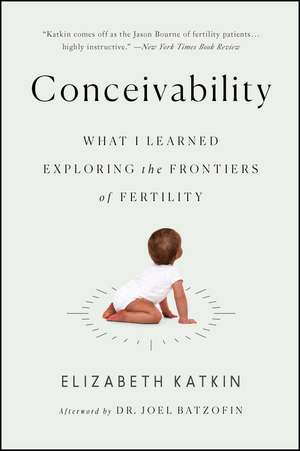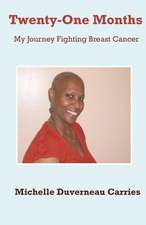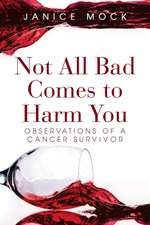Conceivability: What I Learned Exploring the Frontiers of Fertility
Autor Elizabeth Katkinen Limba Engleză Paperback – 24 iul 2019
On paper, conception may seem like a simple biological process, yet this is often hardly the case. While many would like to have children, the road toward conceiving and maintaining a pregnancy can be unexpectedly rocky and winding.
Lawyer Elizabeth Katkin never imagined her quest for children would ultimately involve seven miscarriages, eight fresh IVF cycles, two frozen IVF attempts, five natural pregnancies, four IVF pregnancies, ten doctors, six countries, two potential surrogates, nine years, and roughly $200,000. Despite her three Ivy League degrees and wealth of resources, Katkin found she was woefully undereducated when it came to understanding and confronting her own difficulties having children. After being told by four doctors she should give up, but without an explanation as to what exactly was going wrong with her body, Katkin decided to look for answers herself. The global investigation that followed revealed that approaches to the fertility process taken in many foreign countries are vastly different than those in the US and UK.
In Conceivability, Elizabeth Katkin, now a mother of two, exposes eye-opening information about the medical, financial, legal, scientific, emotional, and ethical issues at stake. “A well-researched, informative, and positive account of a very long journey to motherhood” (Kirkus Reviews), Conceivability sheds light on the often murky and baffling world of conception science. Her book is an invaluable and inspiring text that will be a boon to others navigating the deep and “choppy waters” of fertility treatment (Publishers Weekly), and her chronicle of one of the most difficult, painful, rewarding, and loving journeys a woman can take is as informative as it is poignant.
Preț: 94.04 lei
Nou
Puncte Express: 141
Preț estimativ în valută:
17.100€ • 18.59$ • 14.98£
17.100€ • 18.59$ • 14.98£
Carte disponibilă
Livrare economică 04-18 martie
Preluare comenzi: 021 569.72.76
Specificații
ISBN-13: 9781501142376
ISBN-10: 1501142372
Pagini: 320
Dimensiuni: 140 x 213 x 23 mm
Greutate: 0.3 kg
Editura: Simon&Schuster
Colecția Simon & Schuster
ISBN-10: 1501142372
Pagini: 320
Dimensiuni: 140 x 213 x 23 mm
Greutate: 0.3 kg
Editura: Simon&Schuster
Colecția Simon & Schuster
Notă biografică
Elizabeth Katkin, a lawyer and mother of two, is a former partner at a large international law firm. A graduate of Yale University and Columbia’s Law School and School of International and Public Affairs, she lives with her husband, Richard, and their children in Denver, Colorado. Conceivability is her first book.
Extras
Conceivability
Houston, we have a problem.
Apollo 13
![]()
When Richard and I got married, I was thirty and he was thirty-five. We are both big planners, and along with organizing our wedding and honeymoon, thinking about where we wanted to live now and in the future, and picking out colors for our new house, we had negotiated the kid thing at length well before the wedding. Two kids, not right away, but not too delayed either. I imagined we’d be a foursome by the time I was thirty-five, or shortly thereafter. I was a lawyer, working for the Washington, DC, office of a big Wall Street firm. Richard was a fund manager for an emerging-markets private-equity firm. We both worked a lot, traveled a lot, and had more than our fair share of fun. It was important to us that we have plenty of adventures together before our two kids arrived.
Eighteen months later, weary of the corporate-law grind and encouraged by Richard, I left my law firm for a job at a start-up in Silicon Valley. So what if it required me to commute regularly from DC to California? It was the year 2000, the start-up world was exploding, and I had the energy and drive. I threw myself into preparations for my new life as a West Coast entrepreneur. Before my first trip to Mountain View, California, I was so busy agonizing over what clothes to pack that I forgot to pack my birth control pills. When I discovered them missing, I ran through my options. I wouldn’t have time to get them before going to the new office in the morning. Could Richard overnight them to me? Could my doctor call in a prescription to a nearby CVS? Or . . . Wait a minute. We’d been married for a year and a half. Maybe I’d just stop taking the Pill altogether. The thought was a strange relief.
I called Richard, nervous and excited. Was he ready for a baby?
No, it turned out he was not ready for a baby. Like me, he still lived in a universe in which as soon as a healthy not-too-old woman goes off the Pill, she gets pregnant. He needed time to prepare. “Just a few more months?” he asked. I sighed, made a frantic call to a doctor cousin who faxed off a Pill prescription, and dashed to the pharmacy before it closed. It’s OK, I consoled myself. I could use a few more months too.
As agreed, that June I stopped the Pill. When I tossed the empty pack, I thought to myself that with a little luck, I would be pregnant by the end of the year.
But things didn’t go according to plan. Time passed, yet my period never returned. Month after month: nothing. I grew more agitated by the day, increasingly believing in my gut that something was terribly wrong yet not quite ready to confront it. Work was very stressful, and I buried myself in my new job.
No woman wants to believe that she has a fertility problem. And no one wants to go to that first appointment to find out. Although it should have been pretty clear that I needed an appointment—given that nearly six months after going off the Pill I was not yet ovulating, making it impossible to conceive—I still didn’t make my first appointment with a gynecologist until I felt pushed. By my mother, of course. Richard and I were due to fly to my parents’ home on Long Island for Thanksgiving. My not-so-subtle mother had been dropping lots of hints about grandchildren, and I hadn’t had the heart to tell her that we were actually trying—or more accurately, trying to be trying. But now I wanted to have something to share with my parents when we saw them.
Although it might seem surprising, my conversations with dozens of women revealed that they too held off seeing a doctor. Many dragged their heels before going to a specialist, or even their own gynecologist, and the overwhelming majority did not commit a great deal of time or effort to choosing a fertility clinic—at least their first fertility clinic. When women or couples are ready to seek help, they often choose a doctor or clinic that was referred to them, or that was convenient, or that they have heard of, and they rarely do much digging into things like success rates. Fortunately, in the initial stages at least, the front line in fertility treatment should be fairly standard from clinic to clinic and country to country.
A first visit to a fertility clinic typically involves an exploration of a woman’s cycle and health history, as well as at least a discussion of potential male issues. The initial task is diagnosis—or at least attempting a diagnosis. Is the woman ovulating? Are her tubes blocked? Does she have endometriosis? Are polycystic ovaries or polycystic ovarian syndrome a concern? Does the man have sperm issues? Inadequate sperm count? Low motility (slow swimmers)? Poor morphology (form)? Are any of these identifiable issues possibly masking another issue? In assessing a woman’s odds of conception, doctors will invariably try to assess both egg quality and egg quantity.
My first visit, unfortunately, did not follow this pattern. I began by seeing a recommended ob-gyn in Washington, DC, not dreaming that I needed a fertility clinic. I quickly received my unwelcome first clue that becoming parents was not going to be quite as simple for us as Richard and I had anticipated. Near the end of a brief conversation with the doctor, she told me that I had a condition called polycystic ovarian syndrome (PCOS), a syndrome experienced by an estimated five million women in America (5 to 10 percent of all women of childbearing age), and one of the leading causes of infertility.
I was truly shocked by the diagnosis. There was nothing in my family history, and nothing in Richard’s either, that had caused us concern about getting pregnant. Delivering the news of my diagnosis, the somewhat lethargic gynecologist blithely informed me that it was normal to go a while without a period after coming off birth control pills.
“Six months?” I asked.
“Sure. It’s the polycystic ovarian syndrome. It’s common,” she said, thrusting a pamphlet into my hands. “Read this. It’s no problem. Take Clomid, it makes you ovulate, and you can still conceive naturally.”
I had a syndrome? “Can you tell me a little more about it?” I asked, my heart beating just a bit faster.
“Read the pamphlet,” she shot back, her disorderly salt-and-pepper curls obscuring her face.
“Side effects?”
She headed for the door. “Headaches, nausea.” Just as she pulled the door open for me, she added, “Take Advil.”
I took the pamphlet and prescription from her hands. Clomiphene citrate, or Clomid, 50 mg taken daily, days five through nine of my (theoretical) cycle. It would assist my body with ovulation, and presumably therefore conception. I had no reason not to believe her. I was accustomed to a world in which medicine could fix many problems, even my mother’s life-threatening leukemia several years earlier.
Off I went, home for Thanksgiving turkey with my polycystic ovaries, a synthetic hormone to kick-start the process by inducing a period, 50 mg tablets of Clomid, and a bottle of Advil. My head was spinning with the diagnosis, but I decided I would wait until after Thanksgiving dinner to mention our new problem to my parents. I wanted to eat my turkey and stuffing in peace. But no sooner had I taken off my coat than my mother asked me hopefully, “Any news?”
My mom is an academic, as is my dad. And my brother. And my sister-in-law. No major obstacle or decision in our lives escapes mention without being examined and discussed in minute detail. I had no choice but to tell them about my difficulties and try to field their questions.
“What exactly is polycystic ovarian syndrome?” asked my dad.
Uncharacteristically, I had no real response.
“How does the Clomid work?” asked my mom.
Again, no good answer. I shoveled turkey into my mouth in an unnatural silence.
Those who know me know that I am rarely at a loss for words, and I am usually quick to search for answers. But the doctor had been so dismissive, treating my problem as a triviality, and it wasn’t clear to me what to do or where to go next.
The reality is that I didn’t probe too deeply when I was diagnosed, or for a long time after. And I have discovered that I am not alone in this passivity. Looking back, I realize that I was just happy to have an answer. The doctor told me I had a problem, and that Clomid was the answer. If I just took Clomid, I would ovulate, and then I would become pregnant. Who wouldn’t want to believe that?
Had I done any research then, I’d have learned that Clomid, often the first line of attack in the war against infertility and taken by countless women in America, yields somewhat controversial results.
At first, the Clomid wasn’t so bad for me. I didn’t have painful headaches, as my doctor warned I might, but I also didn’t ovulate. I experienced insomnia and mood swings but, for the most part, life went on. I had other things, for better or worse, to think about. The Internet bubble was bursting, along with company valuations and opportunities for fund-raising. What had started as a challenging but electrifying job in Silicon Valley had turned on its head. Deciding that the hours, travel, and stress could not be helping my poor little eggs to ovulate, and amid a tumultuous shake-up at the firm, I quit. Maybe now I would get my period.
But it was not to be. Three months after my first visit, I was back in the doctor’s office. This time, it took two hours of waiting-room time for her to see me. When else would I have a chance to read People, Cosmopolitan, and AARP The Magazine all in one sitting?
“Still no period?” the ob-gyn asked, in her signature irritated voice.
Still no period.
“Don’t worry. We’ll double the dose. Take one hundred milligrams. Should do the trick.” She wrote up the prescription for Clomid in chicken scrawl and handed it to me. “If it doesn’t work after two cycles, we’ll go up to one hundred and fifty milligrams.” And then she was gone. I was in the office for about three minutes. The waiting-time-to-visit-time ratio was an all-time personal record.
At 100 mg, my head hurt. It was harder and harder to sleep through the night. I snapped at my husband. And still no period.
About three months later, now nearly a year since we began trying for a baby, my dosage was increased again to 150 mg, this time prescribed by phone. I didn’t know then that a third of women with polycystic ovaries—which often occur together with irregular periods—are actually resistant to Clomid, a fact my doctor either didn’t know or neglected to tell me. Head throbbing, and seeing no progress, I started looking for a fertility specialist.
The number one response to egg, ovulatory, or unexplained fertility problems is to prescribe clomiphene citrate, commonly known as Clomid. Taken orally in the early stages of each cycle, the drug is intended to assist a woman’s body with ovulation, and presumably therefore conception, by stimulating the ovaries to release eggs. The most widely used of fertility drugs, Clomid has been on the front line of fertility treatment for more than fifty years and is now a major player in the multibillion-dollar fertility-drug industry.
Perhaps not surprisingly, the business of selling hormonal treatments has existed almost as long as the discovery of hormones. In the early 1900s, a group of British researchers labeled the mysterious secretions that seemed to affect human behavior “hormones” and began to experiment with ways in which they could be transferred from one person to another; for example, using testosterone from a fertile male to help an infertile one.1 These processes evolved over time, making a critically important leap from the exceedingly difficult task of extracting existing hormones—from people, cows’ ovaries, bulls’ testicles—to creating synthetic ones. A major fertility breakthrough occurred unexpectedly in the 1960s when researchers studying clomiphene citrate as a potential oral contraceptive discovered that, to the contrary, it induced ovulation and increased the chances of pregnancy.
Although attempts to control fertility are likely as old as childbirth itself, what was new about Clomid was its method of control: it was the world’s first successful synthetic hormone. Approved by the Food and Drug Administration (FDA) in 1967, fittingly at about the same time that birth control pills first burst onto the scene, Clomid provided the sense that women now were liberated to choose when they wanted to start their families. They could use birth control pills to prevent unwanted pregnancy, and then, when they were ready for a family, take Clomid to help stimulate the body. Compared to the previous options of an invasive surgical procedure with questionable efficacy or lifelong infertility, the orally administered clomiphene citrate was revolutionary.
With the advent of Clomid, the modern-day fertility industry was born. By 1970, demand for Clomid was so great that one doctor in Los Angeles reported, “We don’t have a vial in the house.”2 From its explosive beginnings, Clomid has achieved pride of place over the last fifty-plus years as the knee-jerk prescription doctors write when confronted with a woman trying to get pregnant. Yet unlike with other fertility treatments, the underwhelming pregnancy rates (approximately 10 percent pregnancy rate per cycle) with Clomid have in fact varied little over time,3 while questions about its detrimental impacts have only grown, in light of controversial studies—with conflicting results—examining its possible links to cancer, increased incidence of miscarriage, and birth defects.
Clomid works by blocking the effects of estrogen in a woman’s body, essentially preventing the estrogen from binding to its target on the egg cell. This blocking effect tricks the body into producing greater levels of the two other hormones that are essential to ovulation: follicle stimulating hormone (FSH), which causes the eggs in the ovaries to ripen, preparing for release; and luteinizing hormone (LH), which triggers the release of one or more mature eggs from the follicle. The potential side effects of these hormonal changes, however, include decreased cervical mucus and thinning of the endometrial lining, both critical elements to a successful and healthy conception and implantation.
And that’s not all. Less important, but truly uncomfortable side effects include blurred vision, headaches, hot flashes, mood swings, abdominal pain, weight gain, insomnia, and nausea. Some women find the side effects so challenging that they opt to quit. The actress Helena Bonham Carter, who publicly revealed her and her husband’s struggle to have their second child, cautioned of Clomid, “I had a terrible reaction to it . . . . It stressed me out beyond belief. Hormonally, I was all over the shop, and I got really low emotionally.”4 After quitting the tablets, she joined the “Clomid Club” of disbelievers.
“The Clomid wreaks havoc on some women, particularly those who tend toward depression . . . . It seems especially detrimental to women over forty or those who have low ovarian reserve, since it rarely results in the maturation of more than one follicle for them,” says Jane Gregorie, owner and clinic director of Acupuncture Denver, who often treats women for the side effects of Clomid, which run the gamut from mood swings and depression to headaches and blurred vision, and perhaps most frustratingly, the thinning endometrial linings that present an additional challenge to pregnancy.
“It made me batshit crazy,” Anna told me over coffee at our first meeting, and, adding insult to injury, “it didn’t work.” Now happily the mother of a healthy toddler, Anna battled infertility for more than three years. Although her problems were largely immunological, her journey, characteristically, began with Clomid. A social worker who counsels teens, Anna “was surrounded by people who had sex once and got pregnant.” The Clomid certainly wasn’t helping her cope.
Rose, a teacher in her midthirties, had a similar reaction. “I heard the drugs were going to make me a little weird, but my doctor said no, they wouldn’t,” she told me. Her fears were confirmed, however, after a couple of months of taking the pills. “I had the hardest emotional time on Clomid. I felt angry. I had temper tantrums. I was afraid it would lead to divorce.”
While most fertility patients are only concerned with whether Clomid will work, there is also reason to worry about it working too much. Doctors don’t always inform patients that when it works “too well,” Clomid leads to overstimulation of the ovaries, resulting in a range of problems, from the benign “complication” of twins—occurring 8 to 10 percent of the time5—to the rather more threatening problems of quintuplets or ovarian hyperstimulation syndrome (OHSS), a condition in which a woman’s ovaries swell, causing severe abdominal bloating.6
Its hormonal effects are not lost on those outside the fertility world too. Clomid, which enhances the body’s natural production of progesterone and also conveniently masks steroids on drug tests, is included on the World Anti-Doping Agency list of doping agents in sports. In 2003, the celebrated baseball player Jason Giambi testified to a grand jury that he had taken steroids.7 Included in his cocktail was a white pill that he said might have been Clomid, which some medical experts believe may have exacerbated Giambi’s pituitary tumor a year later.
My doctor’s belief that Clomid would stimulate my ovulation was reasonable. The majority of women who take Clomid do in fact ovulate. Yet this statistic can be misleading. In fact, while up to 60 to 80 percent of women ovulate in response to Clomid, only 15 to 20 percent of women with an irregular or nonexistent cycle actually conceive in a given cycle.8 And while Clomid is prescribed routinely for women with “unexplained infertility,” there is surprisingly little evidence that it really helps them—data reported by top fertility clinics, such as Shady Grove Fertility in Maryland, reveal that using Clomid for anything other than ovulatory irregularities results in a less than 10 percent pregnancy rate per cycle, even when combined with artificial insemination.9 A Cochrane meta-analysis of seven randomized controlled studies showed that in the case of women with unexplained infertility, taking Clomid, whether alone or in conjunction with artificial insemination, had no statistical impact on pregnancy rates or live birth rates.10 This may be in part due to some of the side effects of Clomid, which are not only unpleasant but may actually decrease the odds of getting pregnant.
One in ten women of childbearing age in America has PCOS.11 That’s approximately five million women.12 Though common, polycystic ovaries present a great challenge to fertility. In essence, the ovaries with the cysts do not possess all the hormones needed for an egg to fully mature. In a normal ovary, follicles (little balloon-like sacs that hold and nurture the eggs) grow and fill up with nourishing fluid. One follicle becomes the dominant follicle that, upon ovulation, bursts like an overstuffed balloon, releasing a mature egg into the womb. With polycystic ovaries, however, the follicles start to fill up with fluid as they normally would, but due to insufficient hormones, no dominant follicle develops or pops; rather, the follicles slowly shrink, like balloons losing their air. They remain in the ovaries, some calcifying into cysts. Over time, the number of cysts may increase, causing even greater challenges to ovulation and conception.
Some women with polycystic ovaries experience other changes caused by their hormone imbalance, resulting in a syndrome known as polycystic ovarian syndrome, or PCOS. Acne, weight gain and trouble losing weight, excessive hair growth, depression, and infertility are signs of PCOS. Yet what woman hasn’t experienced at least one or two of these issues in the past? It is precisely because of the vagueness of these seemingly unrelated symptoms, and for many, a lack of discomfort, that the most common hormonal disorder among women of reproductive age often goes undiagnosed. I probably had my polycystic ovaries for years and had absolutely no idea until I tried to get pregnant. In my teen years, I experienced an inexplicable weight gain that in retrospect was likely linked to my PCOS, but no one suspected this, or even raised the possibility, at the time.
The idea behind using Clomid to battle PCOS is simple: the suppression of estrogen is intended to force the struggling body to ovulate by artificially stimulating the necessary hormone production. However, despite its promise in theory, it is now known that Clomid is not the magic solution many hope it to be. In addition to the many women who fail to ovulate with Clomid, many others who do ovulate fail to conceive, likely because of poor egg quality—another challenge I, like a great many women with PCOS, later faced.
Fortunately, women with PCOS facing the challenge of trying to conceive now have another potential option to pursue: a drug called letrozole. Letrozole, an aromatase inhibitor approved by the FDA for the treatment of breast cancer, seeks to achieve the same goal as Clomid—stimulating ovulation—through a different physiological mechanism. Letrozole blocks the production of estrogen, as opposed to preventing the estrogen from binding to the egg cell, as Clomid does.13 A study of 750 women, one of the largest to date examining infertility in women with PCOS, found letrozole to be more effective than Clomid, resulting in higher rates of ovulation, conception, pregnancy, and live birth rates.14 Women assigned to take letrozole experienced an ovulation rate of 61.7 percent and a live birth rate of 27.5 percent, as compared with 48.3 percent and 19.1 percent, respectively, for the Clomid group. Although some experts urge caution, wanting to see more safety data on letrozole,15 Dr. Richard Legro, the lead author of the study, said that the researchers were “extremely encouraged that letrozole could provide a new, oral, first line therapy for this common disorder . . . with a much lower risk of multiple pregnancy.”16
Teen weight gain aside, I luckily suffered almost none of the other side effects of the syndrome—except the most emotionally painful effect: the cysts prevented me from ovulating, making it impossible to conceive without intervention.
Houston, we have a problem.
Apollo 13
1
From Here to Infertility
Frontline Infertility Treatments
When Richard and I got married, I was thirty and he was thirty-five. We are both big planners, and along with organizing our wedding and honeymoon, thinking about where we wanted to live now and in the future, and picking out colors for our new house, we had negotiated the kid thing at length well before the wedding. Two kids, not right away, but not too delayed either. I imagined we’d be a foursome by the time I was thirty-five, or shortly thereafter. I was a lawyer, working for the Washington, DC, office of a big Wall Street firm. Richard was a fund manager for an emerging-markets private-equity firm. We both worked a lot, traveled a lot, and had more than our fair share of fun. It was important to us that we have plenty of adventures together before our two kids arrived.
Eighteen months later, weary of the corporate-law grind and encouraged by Richard, I left my law firm for a job at a start-up in Silicon Valley. So what if it required me to commute regularly from DC to California? It was the year 2000, the start-up world was exploding, and I had the energy and drive. I threw myself into preparations for my new life as a West Coast entrepreneur. Before my first trip to Mountain View, California, I was so busy agonizing over what clothes to pack that I forgot to pack my birth control pills. When I discovered them missing, I ran through my options. I wouldn’t have time to get them before going to the new office in the morning. Could Richard overnight them to me? Could my doctor call in a prescription to a nearby CVS? Or . . . Wait a minute. We’d been married for a year and a half. Maybe I’d just stop taking the Pill altogether. The thought was a strange relief.
I called Richard, nervous and excited. Was he ready for a baby?
No, it turned out he was not ready for a baby. Like me, he still lived in a universe in which as soon as a healthy not-too-old woman goes off the Pill, she gets pregnant. He needed time to prepare. “Just a few more months?” he asked. I sighed, made a frantic call to a doctor cousin who faxed off a Pill prescription, and dashed to the pharmacy before it closed. It’s OK, I consoled myself. I could use a few more months too.
As agreed, that June I stopped the Pill. When I tossed the empty pack, I thought to myself that with a little luck, I would be pregnant by the end of the year.
But things didn’t go according to plan. Time passed, yet my period never returned. Month after month: nothing. I grew more agitated by the day, increasingly believing in my gut that something was terribly wrong yet not quite ready to confront it. Work was very stressful, and I buried myself in my new job.
No woman wants to believe that she has a fertility problem. And no one wants to go to that first appointment to find out. Although it should have been pretty clear that I needed an appointment—given that nearly six months after going off the Pill I was not yet ovulating, making it impossible to conceive—I still didn’t make my first appointment with a gynecologist until I felt pushed. By my mother, of course. Richard and I were due to fly to my parents’ home on Long Island for Thanksgiving. My not-so-subtle mother had been dropping lots of hints about grandchildren, and I hadn’t had the heart to tell her that we were actually trying—or more accurately, trying to be trying. But now I wanted to have something to share with my parents when we saw them.
Although it might seem surprising, my conversations with dozens of women revealed that they too held off seeing a doctor. Many dragged their heels before going to a specialist, or even their own gynecologist, and the overwhelming majority did not commit a great deal of time or effort to choosing a fertility clinic—at least their first fertility clinic. When women or couples are ready to seek help, they often choose a doctor or clinic that was referred to them, or that was convenient, or that they have heard of, and they rarely do much digging into things like success rates. Fortunately, in the initial stages at least, the front line in fertility treatment should be fairly standard from clinic to clinic and country to country.
A first visit to a fertility clinic typically involves an exploration of a woman’s cycle and health history, as well as at least a discussion of potential male issues. The initial task is diagnosis—or at least attempting a diagnosis. Is the woman ovulating? Are her tubes blocked? Does she have endometriosis? Are polycystic ovaries or polycystic ovarian syndrome a concern? Does the man have sperm issues? Inadequate sperm count? Low motility (slow swimmers)? Poor morphology (form)? Are any of these identifiable issues possibly masking another issue? In assessing a woman’s odds of conception, doctors will invariably try to assess both egg quality and egg quantity.
My first visit, unfortunately, did not follow this pattern. I began by seeing a recommended ob-gyn in Washington, DC, not dreaming that I needed a fertility clinic. I quickly received my unwelcome first clue that becoming parents was not going to be quite as simple for us as Richard and I had anticipated. Near the end of a brief conversation with the doctor, she told me that I had a condition called polycystic ovarian syndrome (PCOS), a syndrome experienced by an estimated five million women in America (5 to 10 percent of all women of childbearing age), and one of the leading causes of infertility.
I was truly shocked by the diagnosis. There was nothing in my family history, and nothing in Richard’s either, that had caused us concern about getting pregnant. Delivering the news of my diagnosis, the somewhat lethargic gynecologist blithely informed me that it was normal to go a while without a period after coming off birth control pills.
“Six months?” I asked.
“Sure. It’s the polycystic ovarian syndrome. It’s common,” she said, thrusting a pamphlet into my hands. “Read this. It’s no problem. Take Clomid, it makes you ovulate, and you can still conceive naturally.”
I had a syndrome? “Can you tell me a little more about it?” I asked, my heart beating just a bit faster.
“Read the pamphlet,” she shot back, her disorderly salt-and-pepper curls obscuring her face.
“Side effects?”
She headed for the door. “Headaches, nausea.” Just as she pulled the door open for me, she added, “Take Advil.”
I took the pamphlet and prescription from her hands. Clomiphene citrate, or Clomid, 50 mg taken daily, days five through nine of my (theoretical) cycle. It would assist my body with ovulation, and presumably therefore conception. I had no reason not to believe her. I was accustomed to a world in which medicine could fix many problems, even my mother’s life-threatening leukemia several years earlier.
Off I went, home for Thanksgiving turkey with my polycystic ovaries, a synthetic hormone to kick-start the process by inducing a period, 50 mg tablets of Clomid, and a bottle of Advil. My head was spinning with the diagnosis, but I decided I would wait until after Thanksgiving dinner to mention our new problem to my parents. I wanted to eat my turkey and stuffing in peace. But no sooner had I taken off my coat than my mother asked me hopefully, “Any news?”
My mom is an academic, as is my dad. And my brother. And my sister-in-law. No major obstacle or decision in our lives escapes mention without being examined and discussed in minute detail. I had no choice but to tell them about my difficulties and try to field their questions.
“What exactly is polycystic ovarian syndrome?” asked my dad.
Uncharacteristically, I had no real response.
“How does the Clomid work?” asked my mom.
Again, no good answer. I shoveled turkey into my mouth in an unnatural silence.
Those who know me know that I am rarely at a loss for words, and I am usually quick to search for answers. But the doctor had been so dismissive, treating my problem as a triviality, and it wasn’t clear to me what to do or where to go next.
The reality is that I didn’t probe too deeply when I was diagnosed, or for a long time after. And I have discovered that I am not alone in this passivity. Looking back, I realize that I was just happy to have an answer. The doctor told me I had a problem, and that Clomid was the answer. If I just took Clomid, I would ovulate, and then I would become pregnant. Who wouldn’t want to believe that?
Had I done any research then, I’d have learned that Clomid, often the first line of attack in the war against infertility and taken by countless women in America, yields somewhat controversial results.
At first, the Clomid wasn’t so bad for me. I didn’t have painful headaches, as my doctor warned I might, but I also didn’t ovulate. I experienced insomnia and mood swings but, for the most part, life went on. I had other things, for better or worse, to think about. The Internet bubble was bursting, along with company valuations and opportunities for fund-raising. What had started as a challenging but electrifying job in Silicon Valley had turned on its head. Deciding that the hours, travel, and stress could not be helping my poor little eggs to ovulate, and amid a tumultuous shake-up at the firm, I quit. Maybe now I would get my period.
But it was not to be. Three months after my first visit, I was back in the doctor’s office. This time, it took two hours of waiting-room time for her to see me. When else would I have a chance to read People, Cosmopolitan, and AARP The Magazine all in one sitting?
“Still no period?” the ob-gyn asked, in her signature irritated voice.
Still no period.
“Don’t worry. We’ll double the dose. Take one hundred milligrams. Should do the trick.” She wrote up the prescription for Clomid in chicken scrawl and handed it to me. “If it doesn’t work after two cycles, we’ll go up to one hundred and fifty milligrams.” And then she was gone. I was in the office for about three minutes. The waiting-time-to-visit-time ratio was an all-time personal record.
At 100 mg, my head hurt. It was harder and harder to sleep through the night. I snapped at my husband. And still no period.
About three months later, now nearly a year since we began trying for a baby, my dosage was increased again to 150 mg, this time prescribed by phone. I didn’t know then that a third of women with polycystic ovaries—which often occur together with irregular periods—are actually resistant to Clomid, a fact my doctor either didn’t know or neglected to tell me. Head throbbing, and seeing no progress, I started looking for a fertility specialist.
Clomid
The number one response to egg, ovulatory, or unexplained fertility problems is to prescribe clomiphene citrate, commonly known as Clomid. Taken orally in the early stages of each cycle, the drug is intended to assist a woman’s body with ovulation, and presumably therefore conception, by stimulating the ovaries to release eggs. The most widely used of fertility drugs, Clomid has been on the front line of fertility treatment for more than fifty years and is now a major player in the multibillion-dollar fertility-drug industry.
Perhaps not surprisingly, the business of selling hormonal treatments has existed almost as long as the discovery of hormones. In the early 1900s, a group of British researchers labeled the mysterious secretions that seemed to affect human behavior “hormones” and began to experiment with ways in which they could be transferred from one person to another; for example, using testosterone from a fertile male to help an infertile one.1 These processes evolved over time, making a critically important leap from the exceedingly difficult task of extracting existing hormones—from people, cows’ ovaries, bulls’ testicles—to creating synthetic ones. A major fertility breakthrough occurred unexpectedly in the 1960s when researchers studying clomiphene citrate as a potential oral contraceptive discovered that, to the contrary, it induced ovulation and increased the chances of pregnancy.
Although attempts to control fertility are likely as old as childbirth itself, what was new about Clomid was its method of control: it was the world’s first successful synthetic hormone. Approved by the Food and Drug Administration (FDA) in 1967, fittingly at about the same time that birth control pills first burst onto the scene, Clomid provided the sense that women now were liberated to choose when they wanted to start their families. They could use birth control pills to prevent unwanted pregnancy, and then, when they were ready for a family, take Clomid to help stimulate the body. Compared to the previous options of an invasive surgical procedure with questionable efficacy or lifelong infertility, the orally administered clomiphene citrate was revolutionary.
With the advent of Clomid, the modern-day fertility industry was born. By 1970, demand for Clomid was so great that one doctor in Los Angeles reported, “We don’t have a vial in the house.”2 From its explosive beginnings, Clomid has achieved pride of place over the last fifty-plus years as the knee-jerk prescription doctors write when confronted with a woman trying to get pregnant. Yet unlike with other fertility treatments, the underwhelming pregnancy rates (approximately 10 percent pregnancy rate per cycle) with Clomid have in fact varied little over time,3 while questions about its detrimental impacts have only grown, in light of controversial studies—with conflicting results—examining its possible links to cancer, increased incidence of miscarriage, and birth defects.
Clomid works by blocking the effects of estrogen in a woman’s body, essentially preventing the estrogen from binding to its target on the egg cell. This blocking effect tricks the body into producing greater levels of the two other hormones that are essential to ovulation: follicle stimulating hormone (FSH), which causes the eggs in the ovaries to ripen, preparing for release; and luteinizing hormone (LH), which triggers the release of one or more mature eggs from the follicle. The potential side effects of these hormonal changes, however, include decreased cervical mucus and thinning of the endometrial lining, both critical elements to a successful and healthy conception and implantation.
And that’s not all. Less important, but truly uncomfortable side effects include blurred vision, headaches, hot flashes, mood swings, abdominal pain, weight gain, insomnia, and nausea. Some women find the side effects so challenging that they opt to quit. The actress Helena Bonham Carter, who publicly revealed her and her husband’s struggle to have their second child, cautioned of Clomid, “I had a terrible reaction to it . . . . It stressed me out beyond belief. Hormonally, I was all over the shop, and I got really low emotionally.”4 After quitting the tablets, she joined the “Clomid Club” of disbelievers.
“The Clomid wreaks havoc on some women, particularly those who tend toward depression . . . . It seems especially detrimental to women over forty or those who have low ovarian reserve, since it rarely results in the maturation of more than one follicle for them,” says Jane Gregorie, owner and clinic director of Acupuncture Denver, who often treats women for the side effects of Clomid, which run the gamut from mood swings and depression to headaches and blurred vision, and perhaps most frustratingly, the thinning endometrial linings that present an additional challenge to pregnancy.
“It made me batshit crazy,” Anna told me over coffee at our first meeting, and, adding insult to injury, “it didn’t work.” Now happily the mother of a healthy toddler, Anna battled infertility for more than three years. Although her problems were largely immunological, her journey, characteristically, began with Clomid. A social worker who counsels teens, Anna “was surrounded by people who had sex once and got pregnant.” The Clomid certainly wasn’t helping her cope.
Rose, a teacher in her midthirties, had a similar reaction. “I heard the drugs were going to make me a little weird, but my doctor said no, they wouldn’t,” she told me. Her fears were confirmed, however, after a couple of months of taking the pills. “I had the hardest emotional time on Clomid. I felt angry. I had temper tantrums. I was afraid it would lead to divorce.”
While most fertility patients are only concerned with whether Clomid will work, there is also reason to worry about it working too much. Doctors don’t always inform patients that when it works “too well,” Clomid leads to overstimulation of the ovaries, resulting in a range of problems, from the benign “complication” of twins—occurring 8 to 10 percent of the time5—to the rather more threatening problems of quintuplets or ovarian hyperstimulation syndrome (OHSS), a condition in which a woman’s ovaries swell, causing severe abdominal bloating.6
Its hormonal effects are not lost on those outside the fertility world too. Clomid, which enhances the body’s natural production of progesterone and also conveniently masks steroids on drug tests, is included on the World Anti-Doping Agency list of doping agents in sports. In 2003, the celebrated baseball player Jason Giambi testified to a grand jury that he had taken steroids.7 Included in his cocktail was a white pill that he said might have been Clomid, which some medical experts believe may have exacerbated Giambi’s pituitary tumor a year later.
My doctor’s belief that Clomid would stimulate my ovulation was reasonable. The majority of women who take Clomid do in fact ovulate. Yet this statistic can be misleading. In fact, while up to 60 to 80 percent of women ovulate in response to Clomid, only 15 to 20 percent of women with an irregular or nonexistent cycle actually conceive in a given cycle.8 And while Clomid is prescribed routinely for women with “unexplained infertility,” there is surprisingly little evidence that it really helps them—data reported by top fertility clinics, such as Shady Grove Fertility in Maryland, reveal that using Clomid for anything other than ovulatory irregularities results in a less than 10 percent pregnancy rate per cycle, even when combined with artificial insemination.9 A Cochrane meta-analysis of seven randomized controlled studies showed that in the case of women with unexplained infertility, taking Clomid, whether alone or in conjunction with artificial insemination, had no statistical impact on pregnancy rates or live birth rates.10 This may be in part due to some of the side effects of Clomid, which are not only unpleasant but may actually decrease the odds of getting pregnant.
Polycystic Ovaries and Polycystic Ovarian Syndrome (PCOS)
One in ten women of childbearing age in America has PCOS.11 That’s approximately five million women.12 Though common, polycystic ovaries present a great challenge to fertility. In essence, the ovaries with the cysts do not possess all the hormones needed for an egg to fully mature. In a normal ovary, follicles (little balloon-like sacs that hold and nurture the eggs) grow and fill up with nourishing fluid. One follicle becomes the dominant follicle that, upon ovulation, bursts like an overstuffed balloon, releasing a mature egg into the womb. With polycystic ovaries, however, the follicles start to fill up with fluid as they normally would, but due to insufficient hormones, no dominant follicle develops or pops; rather, the follicles slowly shrink, like balloons losing their air. They remain in the ovaries, some calcifying into cysts. Over time, the number of cysts may increase, causing even greater challenges to ovulation and conception.
Some women with polycystic ovaries experience other changes caused by their hormone imbalance, resulting in a syndrome known as polycystic ovarian syndrome, or PCOS. Acne, weight gain and trouble losing weight, excessive hair growth, depression, and infertility are signs of PCOS. Yet what woman hasn’t experienced at least one or two of these issues in the past? It is precisely because of the vagueness of these seemingly unrelated symptoms, and for many, a lack of discomfort, that the most common hormonal disorder among women of reproductive age often goes undiagnosed. I probably had my polycystic ovaries for years and had absolutely no idea until I tried to get pregnant. In my teen years, I experienced an inexplicable weight gain that in retrospect was likely linked to my PCOS, but no one suspected this, or even raised the possibility, at the time.
The idea behind using Clomid to battle PCOS is simple: the suppression of estrogen is intended to force the struggling body to ovulate by artificially stimulating the necessary hormone production. However, despite its promise in theory, it is now known that Clomid is not the magic solution many hope it to be. In addition to the many women who fail to ovulate with Clomid, many others who do ovulate fail to conceive, likely because of poor egg quality—another challenge I, like a great many women with PCOS, later faced.
Fortunately, women with PCOS facing the challenge of trying to conceive now have another potential option to pursue: a drug called letrozole. Letrozole, an aromatase inhibitor approved by the FDA for the treatment of breast cancer, seeks to achieve the same goal as Clomid—stimulating ovulation—through a different physiological mechanism. Letrozole blocks the production of estrogen, as opposed to preventing the estrogen from binding to the egg cell, as Clomid does.13 A study of 750 women, one of the largest to date examining infertility in women with PCOS, found letrozole to be more effective than Clomid, resulting in higher rates of ovulation, conception, pregnancy, and live birth rates.14 Women assigned to take letrozole experienced an ovulation rate of 61.7 percent and a live birth rate of 27.5 percent, as compared with 48.3 percent and 19.1 percent, respectively, for the Clomid group. Although some experts urge caution, wanting to see more safety data on letrozole,15 Dr. Richard Legro, the lead author of the study, said that the researchers were “extremely encouraged that letrozole could provide a new, oral, first line therapy for this common disorder . . . with a much lower risk of multiple pregnancy.”16
Teen weight gain aside, I luckily suffered almost none of the other side effects of the syndrome—except the most emotionally painful effect: the cysts prevented me from ovulating, making it impossible to conceive without intervention.
Recenzii
Praise for CONCEIVABILITY by ELIZABETH KATKIN
“Katkin comes off as the Jason Bourne of fertility patients…[Conceivability is] highly instructive on things like the difference between fresh and frozen I.V.F. cycles, the need to ask pointed questions at fertility clinics and the value of taking risks on less conventional treatments. Katkin unrelentingly questions the whole infertility industrial complex. Under her cross-examination, the expert opinions of various doctors seem to wilt.”—New York Times Book Review
"[Katkin's] story reveals the importance of becoming a savvy, educated consumer, questioning fertility protocols, and investigating different options. She also examines the ethical questions surrounding egg and sperm donation, and helps readers unpack confusing and sometimes conflicting laws. Katkin’s lawyerly thoroughness has resulted in an invaluable and inspiring text that will be a boon to others navigating the deep and “choppy waters” of fertility treatment."—Publishers Weekly
“In her debut memoir, [Katkin] shares the various methods she and her husband used to finally have two healthy children in their lives. Katkin also incorporates the stories of other couples, giving a wide-angle look at the pros and cons of medical intervention, the use of surrogate mothers, and the extreme measures many will go to in order to have a baby. A well-researched, informative, and positive account of a very long journey to motherhood.”—Kirkus Reviews
"Elizabeth Katkin’s Conceivability—at once a poignant personal narrative and an impeccably researched account of the baffling realities of the baby business—is a clarion call for a far more thoughtful, more humane approach to one of the most emotionally charged of life’s challenges. A must read for patients and caregivers alike." —Julia Indichova, author of The Fertile Female and Inconceivable
“Katkin comes off as the Jason Bourne of fertility patients…[Conceivability is] highly instructive on things like the difference between fresh and frozen I.V.F. cycles, the need to ask pointed questions at fertility clinics and the value of taking risks on less conventional treatments. Katkin unrelentingly questions the whole infertility industrial complex. Under her cross-examination, the expert opinions of various doctors seem to wilt.”—New York Times Book Review
"[Katkin's] story reveals the importance of becoming a savvy, educated consumer, questioning fertility protocols, and investigating different options. She also examines the ethical questions surrounding egg and sperm donation, and helps readers unpack confusing and sometimes conflicting laws. Katkin’s lawyerly thoroughness has resulted in an invaluable and inspiring text that will be a boon to others navigating the deep and “choppy waters” of fertility treatment."—Publishers Weekly
“In her debut memoir, [Katkin] shares the various methods she and her husband used to finally have two healthy children in their lives. Katkin also incorporates the stories of other couples, giving a wide-angle look at the pros and cons of medical intervention, the use of surrogate mothers, and the extreme measures many will go to in order to have a baby. A well-researched, informative, and positive account of a very long journey to motherhood.”—Kirkus Reviews
"Elizabeth Katkin’s Conceivability—at once a poignant personal narrative and an impeccably researched account of the baffling realities of the baby business—is a clarion call for a far more thoughtful, more humane approach to one of the most emotionally charged of life’s challenges. A must read for patients and caregivers alike." —Julia Indichova, author of The Fertile Female and Inconceivable















